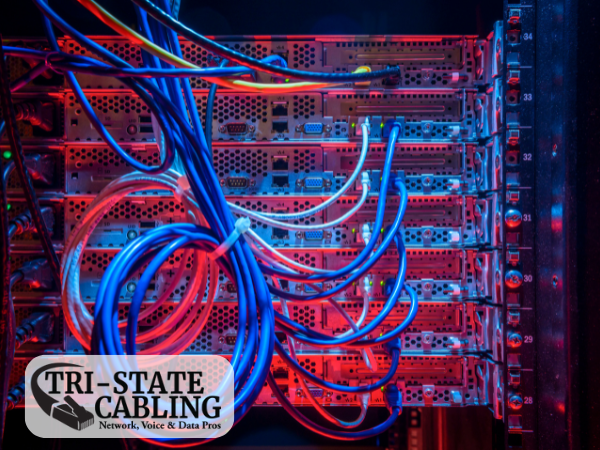
Why are there so many cables in your data rack?
When you walk into a data center, one of the first things you’ll notice is the sea of cables running in and out of server racks. To the untrained eye, this might seem chaotic and overwhelming. However, each cable serves a crucial role in maintaining the performance, security, and efficiency of the data center.
In this guide, we’ll explore why server racks have so many cables, the importance of server rack organization, and tips for a server rack clean up.
Understanding the Role of Server Rack Cables
Server rack cables are essential for connecting various components within a data center. These cables handle everything from power delivery to data transmission, ensuring that all the servers, switches, and storage devices communicate effectively.
Here are some key functions of server rack cables:
- Power Supply: Cables provide the necessary electricity to power servers and other equipment.
- Data Transmission: Network cables facilitate data exchange between servers, storage devices, and external networks.
- Peripheral Connections: Various cables connect peripheral devices such as monitors, keyboards, and mice to the servers.
Types of Server Rack Cables
There are several types of cables commonly found in server racks, including:
- Power Cables: These are used to supply power to the servers and other equipment.
- Ethernet Cables: Used for network connections, allowing servers to communicate with each other and with external networks.
- Fiber Optic Cables: These provide high-speed data transmission, essential for large-scale data centers.
- Console Cables: Used for managing and configuring servers and network devices.
The Importance of Server Rack Organization
A well-organized server rack is crucial for the efficient operation of a data center. Proper server rack organization can lead to:
- Improved Airflow: Properly routed cables prevent obstruction of airflow, helping to keep equipment cool and reducing the risk of overheating.
- Easier Maintenance: Organized cables make it easier to identify and address issues, reducing downtime and maintenance time.
- Enhanced Performance: With reduced interference and optimized connections, well-organized server racks can improve overall system performance.
Strategies for Effective Server Rack Organization
- Labeling: Clearly label each cable to identify its function and destination. This makes it easier to troubleshoot and manage connections.
- Cable Management Accessories: Use cable managers, such as cable trays, racks, and ties, to keep cables neatly organized and secured.
- Color Coding: Implement a color-coding system to quickly identify different types of cables and their functions.
Tips for a Server Rack Clean Up
Over time, server racks can become cluttered with unused or outdated cables. Regular server rack clean up is essential to maintaining efficiency and organization. Here are some tips for a successful clean up:
- Inventory Cables: Start by taking an inventory of all the cables in your server rack. Identify which cables are necessary and which can be removed.
- Remove Unused Cables: Disconnect and remove any cables that are no longer in use. This reduces clutter and improves airflow.
- Reorganize Remaining Cables: Use cable managers and other accessories to neatly route and secure the remaining cables. Ensure that they are labeled and easily accessible.
- Inspect and Replace: Check all cables for signs of wear or damage. Replace any cables that are frayed or malfunctioning to prevent future issues.
The Role of Cable Managers in Data Centers
Cable managers are indispensable tools in any data center. They help maintain order and organization within server racks, ensuring that cables are neatly routed and secured. Here are some types of cable managers and their benefits:
- Cable Trays: These provide a pathway for cables, keeping them off the floor and preventing tangling.
- Cable Ties: These secure cables in place, preventing them from becoming loose or tangled.
- Cable Racks: These offer a structured way to route cables, making it easier to manage large quantities of cables.
Benefits of Using Cable Managers
- Improved Organization: Cable managers help keep cables neatly arranged, making it easier to identify and access specific cables.
- Reduced Downtime: With organized cables, it’s easier to troubleshoot and resolve issues quickly, minimizing downtime.
- Enhanced Safety: Properly managed cables reduce the risk of tripping hazards and damage to the cables themselves.
Contact Tri-State Cabling for Data Rack Clean Up in New York and New Jersey
Server racks have many cables because each one plays a vital role in the operation of a data center. From power supply to data transmission, these cables ensure that all components work together seamlessly. However, without proper server rack organization and regular server rack clean up, the abundance of cables can lead to chaos and inefficiency.
By understanding the types of server rack cables and their functions, implementing effective organization strategies, and utilizing cable managers, you can maintain a clean, efficient, and high-performing data center. Remember, the key to a well-functioning server rack lies in the meticulous management of its many cables.
Contact Tri-State Cabling for data rack clean up in New York and New Jersey.
